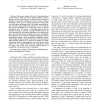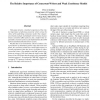84 search results - page 13 / 17 » Anonymizing sequential releases |
ACSC
2008
IEEE
15 years 1 months ago
2008
IEEE
A number of organizations publish microdata for purposes such as public health and demographic research. Although attributes of microdata that clearly identify individuals, such a...
171
Voted
CSFW
2011
IEEE
13 years 11 months ago
2011
IEEE
—This paper explores the idea of knowledge-based security policies, which are used to decide whether to answer queries over secret data based on an estimation of the querier’s ...
ICDCS
1996
IEEE
15 years 3 months ago
1996
IEEE
This paper presents a detailed comparison of the relative importance of allowing concurrent writers versus the choice of the underlying consistency model. Our comparison is based ...
CIKM
2009
Springer
15 years 6 months ago
2009
Springer
Data generalization is widely used to protect identities and prevent inference of sensitive information during the public release of microdata. The k-anonymity model has been exte...
104
click to vote
NAR
1998
14 years 11 months ago
1998
The Protein Information Resource (PIR; http://wwwnbrf.georgetown.edu/pir/ ) supports research on molecular evolution, functional genomics, and computational biology by maintaining...



